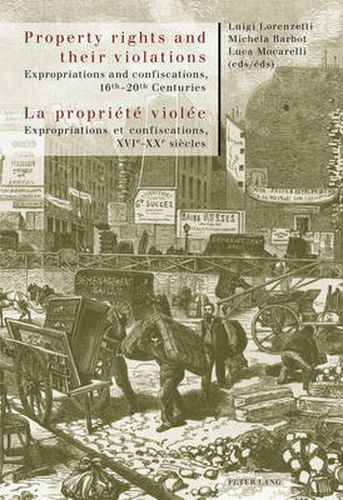Readings Newsletter
Become a Readings Member to make your shopping experience even easier.
Sign in or sign up for free!
You’re not far away from qualifying for FREE standard shipping within Australia
You’ve qualified for FREE standard shipping within Australia
The cart is loading…






This title is printed to order. This book may have been self-published. If so, we cannot guarantee the quality of the content. In the main most books will have gone through the editing process however some may not. We therefore suggest that you be aware of this before ordering this book. If in doubt check either the author or publisher’s details as we are unable to accept any returns unless they are faulty. Please contact us if you have any questions.
Interest in the history of ownership rights is growing and spreading to different disciplines. Historians are turning their attention mainly to the rise of private and individual ownership as it was codified in 19th-century liberal Europe. In writing this history, however, their perspective has too often ignored the other side of the coin, namely the restrictions which the sovereign imposed on such rights, allegedly in the interest of the community.
The papers collected in the present volume suggest that private property is not necessarily the most safeguarded legal model, hence it is not less vulnerable to violation. They construct a close analysis of the most common forms of abuse of private property on record - expropriation, seizure, and confiscation - perpetrated by public authorities. They also seek to define the uneasy, often intricate relation between legal and legitimate. In a perspective of lights and shadows, the role of confiscation and expropriation changes : now seen as powerful instruments of change, now as enduring factors of conservation in the evolution of private ownership rights.
Les droits de propriete sont depuis longtemps au coeur de l'interet de diverses disciplines. L'attention des historiens s'est focalisee surtout sur la naissance de la propriete privee et individuelle telle qu'elle a ete codifiee dans l'Europe liberale du XIXe siecle. Toutefois, son histoire a trop souvent neglige l'autre face de la medaille, a savoir les limites fixees a ce droit par le souverain au nom de l'interet de la collectivite. Les contributions figurant dans ce volume suggerent que la propriete privee individuelle ne represente pas le modele juridique le plus apte a la proteger face aux risques d'infraction. Au coeur des analyses il y a les formes historiques de la violation de la propriete privee - expropriations, saisies, confiscations - perpetrees par les autorites et le rapport, souvent complexe et ambigue, entre les dimensions de la legalite et de la legitimite. Dans un jeu d'ombres et de lumieres, les confiscations et les expropriations se dessinent a la fois comme de puissants instruments de changement et de tenaces facteur de conservation dans l'evolution des formes de propriete.
$9.00 standard shipping within Australia
FREE standard shipping within Australia for orders over $100.00
Express & International shipping calculated at checkout
This title is printed to order. This book may have been self-published. If so, we cannot guarantee the quality of the content. In the main most books will have gone through the editing process however some may not. We therefore suggest that you be aware of this before ordering this book. If in doubt check either the author or publisher’s details as we are unable to accept any returns unless they are faulty. Please contact us if you have any questions.
Interest in the history of ownership rights is growing and spreading to different disciplines. Historians are turning their attention mainly to the rise of private and individual ownership as it was codified in 19th-century liberal Europe. In writing this history, however, their perspective has too often ignored the other side of the coin, namely the restrictions which the sovereign imposed on such rights, allegedly in the interest of the community.
The papers collected in the present volume suggest that private property is not necessarily the most safeguarded legal model, hence it is not less vulnerable to violation. They construct a close analysis of the most common forms of abuse of private property on record - expropriation, seizure, and confiscation - perpetrated by public authorities. They also seek to define the uneasy, often intricate relation between legal and legitimate. In a perspective of lights and shadows, the role of confiscation and expropriation changes : now seen as powerful instruments of change, now as enduring factors of conservation in the evolution of private ownership rights.
Les droits de propriete sont depuis longtemps au coeur de l'interet de diverses disciplines. L'attention des historiens s'est focalisee surtout sur la naissance de la propriete privee et individuelle telle qu'elle a ete codifiee dans l'Europe liberale du XIXe siecle. Toutefois, son histoire a trop souvent neglige l'autre face de la medaille, a savoir les limites fixees a ce droit par le souverain au nom de l'interet de la collectivite. Les contributions figurant dans ce volume suggerent que la propriete privee individuelle ne represente pas le modele juridique le plus apte a la proteger face aux risques d'infraction. Au coeur des analyses il y a les formes historiques de la violation de la propriete privee - expropriations, saisies, confiscations - perpetrees par les autorites et le rapport, souvent complexe et ambigue, entre les dimensions de la legalite et de la legitimite. Dans un jeu d'ombres et de lumieres, les confiscations et les expropriations se dessinent a la fois comme de puissants instruments de changement et de tenaces facteur de conservation dans l'evolution des formes de propriete.